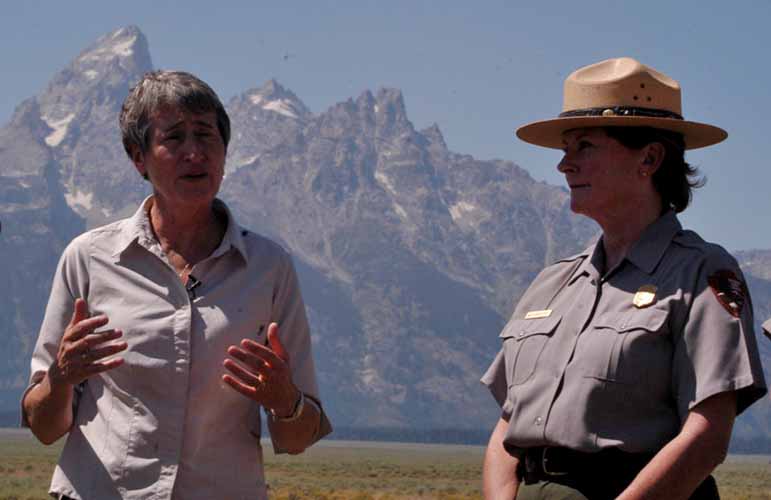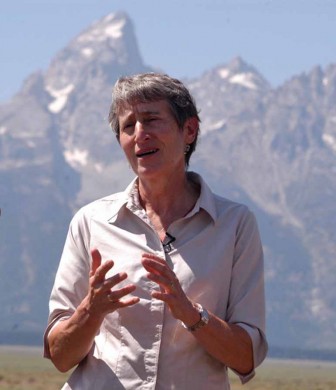
MOOSE, WYO. — Though she lacks the required money and is facing a January deadline, Interior Secretary Sally Jewell said Wednesday that she was making it a “very high priority” to honor a deal for the federal government to acquire 1,280 acres of Wyoming lands located inside Grand Teton National Park.
“I can see why this is important,” Jewell said during a press conference held at the edge of a 640-acre parcel in Antelope Flats that was set aside when Wyoming became a state, and is meant to be used to for school funding. “I can’t imagine this being developed.”
With the Tetons in the background, Jewell told reporters it would be a shame for the square mile of sagebrush flats near picturesque Mormon Row and the often-photographed Moulton Barn to be developed with up to three dozen private residences, a scenario that could conceivably happen if Wyoming sells the land.
For decades, Wyoming officials have wanted the federal government to pay for a handful of state parcels surrounded by the park. Wyoming’s constitution requires that the lands, held in trust for public schools, be managed to realize their maximum potential revenue. In recent years, that has meant state revenues of less than $2,000 per year in cattle grazing fees for two 640-acre parcels.

When former Gov. Dave Freudenthal in 2010 threatened to sell the lands to the highest bidder, negotiations went into high gear, and a deal was struck to acquire all state inholdings for a total of $107 million in four phases. Two parcels have been sold for $16 million, with the Antelope Flats acreage and 640 acres along the Gros Ventre Road adjacent to the eastern park boundary each valued at approximately $45 million.
An agreement governing the deal requires Interior to pay $45 million for the Antelope Flats land by Jan 5, then buy the Gros Ventre land sometime afterward. But with current and future federal budget scenarios unlikely to yield the estimated $91 million needed to complete those purchases, Jewell is looking for another way to acquire the acreage.
Instead of cash for the land, Grand Teton Superintendent Mary Gibson Scott and Wyoming Office of State Land and Investments Director Ryan Lance have explored the possibility of a land swap.
Under the preliminary strokes of a complex deal, the state could trade the Grand Teton parcels for unspecified U.S. Bureau of Land Management acreage and underlying mineral rights elsewhere in Wyoming. As part of that deal, Lance is also looking to trade state lands near the Wyoming towns of Gillette and Lander that, like the Grand Teton parcels, are environmentally sensitive and could face development.
But any such land swap would have to be of benefit to not only the National Park Service and Wyoming, but also the BLM, Jewell said.
“The BLM is not a piggy bank that can be tapped for land exchanges,” she said.
Finding value for the BLM may lie in a combination of factors, including streamlining its land management duties by finding the agency more contiguous acres, rather than fractured parcels, and in protecting critical sage grouse habitat.
The Grand Teton parcels are greater-sage grouse habitat that should be protected, Jewell said, and doing so could benefit the BLM, which is struggling to protect the bird from encroaching energy development and rural subdivisions in Wyoming and across the West.
Jewell said the Grand Teton parcels rank high on her list of lands worthy of federal acquisition, but stressed that it can’t happen without a creative approach and “a lot of hard work.”
Despite a January deadline for the Antelope Flats deal—a target that looks increasingly unlikely—Jewell said she saw Wyoming Gov. Matt Mead as a “cooperative and willing partner” in the search for a workable solution.
“I asked the governor for flexibility in the timing,” she said, during what she called an “encouraging” conversation with Mead earlier this week.
Sharon Mader, Grand Teton program manager for the National Parks Conservation Association, said she applauded Jewell’s “commitment to do what it takes to preserve the scenic park landscape.”
“Protecting these critical lands is fundamental to passing Grand Teton National Park down to future generations intact,” Mader said in a statement Wednesday.
Scott said she was pleased that Jewell visited the park to see first-hand the land in question, which helps justify “some pretty incomprehensible numbers” for property values .
It would benefit not just the Park Service, but also Wyoming, to complete the deal, Scott said.
“We’re excited to resolve something that for 75 years has been hanging out there and needs to be addressed,” she said.
Contact Ruffin Prevost at 307-213-9818 or [email protected].
